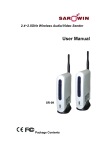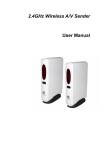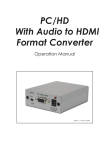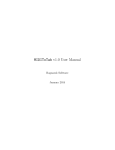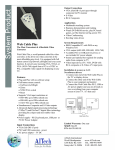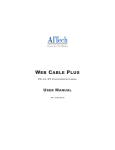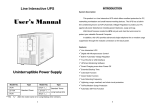Download AITech ProA/V Media Extender Mini
Transcript
AITech ProA/V Media Extender Mini User Manual Package Contents • Transmitter x 1 • Receiver x 1 • Infrared (IR) eye cable x 1 • Remote antenna x 1 • Audio/Video cable x 2 • Power adaptors (DC6V) x 2 • User manual x 1 Note: The transmitter and the receiver look very similar. You can find “transmitter” and “receiver” labels on the side of the units. See Fig. 1. Fig. 1 Receiver Transmitter Receiver Transmitter Product Layout Transmitter/Receiver (See Fig. 2 and Fig. 3) 1. Power/Channel Indicator 2. IR Window 3. Channel Select Button (Select the channel by pressing the tact switch to the channel number you want. Select the same channel both on the transmitter and the receiver). 4. Audio Jack (Red) 5. Audio Jack (White) 6. Video Jack (Yellow) 7. Power On/Off 8. Power Adaptor Plug 9. IR Eye (Transmitter) / Antenna(Receiver) 1 Fig. 2 1 Receiver/Transmitter 2 3 Fig. 3 4 4 5 5 6 6 7 7 8 8 9 9 Transmitter Receiver Setting Up Before you make the connection: • Set the channel by pressing the select button on the front of the transmitter and the receiver to the same channel. 1. Setting up the Transmitter 1.1 Connect the Transmitter to an A/V Component A/V Connection Connect the mini-plug of the provided A/V cables to the A/V jack on the rear of the transmitter; connect the other end of the cables to the A/V 2 jacks of the A/V component labeled LINE OUT. See Fig. 4. Fig. 4 A/V Cable OUT VIDEO AUDIO Transmitter Satellite receiver/DVD/VCD RF Connection – for A/V Component without Spare A/V Output Jacks If your A/V component has only one set of A/V output jacks, and you want to use it with a nearby TV, connect coaxial cable from the signal OUT port on the A/V component to the VHF/UHF IN port on your TV. In order to also view cable transmission on that TV, connect your incoming cable TV source to the single IN port of the A/V component. Please see Fig. 5. Fig. 5 Transmitter RF OUT VHF/UHF VIDEO TV AUDIO IN A/V Component 3 Note 1: On a NTSC system, the connector on the A/V equipment is an RCA jack. Connect the yellow plug to the jack labeled VIDEO, the red plug to the jack labeled AUDIO RIGHT and the white plug to the jack labeled AUDIO LEFT. Note 2: If the A/V equipment has only one output for audio (mono sound only), connect the white plug to that single audio output jack. 1.2 Power Supply a. Plug one end of the provided power adaptor into a wall outlet and the other end into the rear of the transmitter. See Fig. 6. b. Turn on the transmitter. light up. The LED on the front of the unit should Fig. 6 POW ER ON-OFF Wall Outlet Transmitter 2. Setting up the Receiver 2.1 Connect the Receiver to a TV A/V Connect – for TV with A/V Input Jacks Connect the mini-plug of the provided A/V cables to the A/V jack on the rear of the receiver; connect the other end of the cable to the A/V jacks on the TV labeled LINE IN. See Fig. 7. 4 Fig. 7 VIDEO AUDIO IN TV A/V Cable Receiver RF Connection – for TV without A/V Input Jacks If there is no A/V input jacks on your TV, you will need to get an RF modulator (available at your local electronics store) to make the connection between TV and receiver. See Fig. 8. Fig. 8 Receiver A/V Cable VHF/UHF VIDEO TV AUDIO IN CH 3/4 RF OUT RF Modulator Connection through an A/V Component If an A/V component (VCR, DVD player, DBS receiver, and etc.) is connected to the TV already, you can just connect the receiver to the free LINE IN jacks on the A/V component. See Fig. 9. 5 Fig. 9 Receiver A/V Cable RF OUT VHF/UHF VIDEO TV AUDIO IN A/V Component Note 1: Connect the yellow plug to the jack labeled VIDEO, the red plug to the jack labeled AUDIO RIGHT and the white plug to the jack labeled AUDIO LEFT. Note 2: If the TV has only one input for audio (mono sound only), connect the white plug to that single audio in jack. 2.2 Connecting the Remote Antenna a. Connect the provided remote antenna with the receiver by plugging it in the hole labeled Ant. on the receiver. b. If possible, make the antenna straight. Do not bend the antenna. See Fig. 10. Fig. 10 Receiver 2.3 Remote Antenna Power Supply a. Plug one end of the provided power adaptor into a wall outlet and 6 the other end into the rear of the receiver. See Fig. 11. b. Turn on the receiver. up. The LED on the front of the unit should light Fig. 11 POW ER ON-OFF Wall Outlet Receiver Other Applications Using Remote Control The Wireless A/V Sender gives you the ability to control A/V components from another room using your existing remote control device. To use this function, follow the steps below: 1. Place the transmitter next/close to the A/V source component and plug the IR eye into the jack located on the rear of the transmitter (IR Eye plug). Adhere the IR eye directly to the IR window on the front of the source component (see Fig. 12) OR place the IR eye in front of the source component (see Fig. 13). AV Source Component Fig. 12 Transmitter IR Eye TV Receiver Fig. 13 Remote Control AV Source Component 7 Transmitter IR Eye TV Receiver Remote Control 2. Position the receiver so that your remote control signal can strike the IR window on the front of the receiver. Set the remote antenna on the receiver straight. Do not bend the remote antenna. 3. To use your remote control, point it at the front of the receiver and operate it as you normally would. Specifications Transmitter/Receiver A/V Transmitting Frequency IR Extender Frequency 2.4GHz 433.92MHz A/V Signal Range IR Extender Range Antenna 100 meters (300 feet) clear line of sight 70 meters (200 feet) clear line of sight Built-in antenna Channel 4 selectable channels Audio Video Stereo audio input and output Composite input and output Dimensions Weight 12.5 x 8 x 2.5 (cm) for transmitter/receiver 125g for transmitter/receiver Power DC6V, 500mA Operating Temperature 0C ~ 40C (32F ~ 104F) Providing the latest technologies to our customers is our responsibility; therefore, we reserve the right to change the specifications without prior notice. 8 Trouble Shooting If you are not getting any signal at all • Check that the transmitter and receiver are properly connected to the A/V components from which you want to send/receive the A/V signal. • Make sure the transmitter and the receiver are turned on. • Check power switches on the remote TV and video source (VCR, DVD player, satellite receiver, etc). • Make sure power plugs are pushed all the way in. • Check all cable connections. • Check the CHANNEL switch on both transmitter and receiver are set to the same number. • If you connect the receiver to a TV through an RF modulator, check that the TV is tuned to the same channel as the TV Channel switch on the RF modulator (3 or 4). If the signal is poor, or there is interference • Adjust the transmitter by rotating orientations until you get the best reception. • Change the channel on both transmitter and receiver and make them the same. • If there is a microwave oven in use in the path between the transmitter and receiver, remove the microwave oven or turn it off. • Make sure the transmitter and receiver are within range of each other (range of approximately 300 feet; 100 meters in a clear line of sight). Care and Maintenance • Keep all its parts and accessories out of the reach of young children. • Do not attempt to open the case. Non-expert handling of the device may damage it. • Keep dry. Precipitation, humidity, and liquids, contain minerals that will corrode electronic circuits. • Do not use or store in dusty, dirty areas. Moving parts may be damaged. • Do not store in hot areas. High temperatures can shorten the life of electronic devices and warp or melt certain plastics. • Do not store in very cold areas. When the A/V sender warms up (to its normal temperature), moisture can form inside the case, which may damage electronic circuit boards. 9 • Do not drop, knock, or shake it. Rough handling can break internal circuit boards. • Do not use harsh chemicals, cleaning solvents, or strong detergents when cleaning. • Operate this product using only the power supply included with it. • Do not overload electrical outlets or extension cords as this can result in fire or electric shock. FCC Label Compliance Statement: This device complies with Part 15 of the FCC Rules. Operation is subject to the following two conditions: (1) this device may not cause harmful interference, and (2) this device must accept any interference received, including interference that may cause undesired operation. Note: The manufacturer is not responsible for any radio or TV interference caused by unauthorized modifications to this equipment. Such modifications could void the user's authority to operate the equipment. 10











